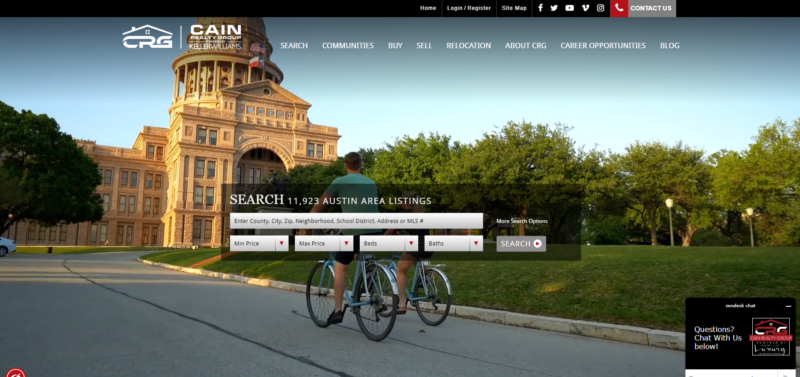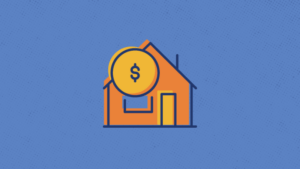How to Build a Real Estate Website for Lead Generation
October 9, 2023
Real Estate CRM, Real Estate Marketing

How to Build a Real Estate Website for Lead Generation
The difference between a good real estate team and a great one often comes down to how effective they are at coming up with and converting quality leads. Even in hot markets, this can be a challenge, which is why the most skilled know how to take advantage of a wide range of lead gen strategies, from working their sphere of influence to hosting open houses to building out advertising campaigns.
Still, all of these strategies take time — and who has any of that these days? This is why more agents are now leaning into their websites and turning them into a key component of their lead gen strategies. No longer just a way to showcase a few recent properties or sell their services, these real estate websites are instead helping them become even more effective and efficient at turning curious visitors into closed deals.
So let’s take a closer look at the steps you can take to transform your website into a lead gen engine.
Real estate websites and lead gen
Today’s agents and real estate teams can no longer afford to treat their websites as an afterthought. Although it may be fast and easy to simply throw up a few photos alongside some contact information and call it a day, this isn’t enough to compete in today’s markets.
Consider the fact that, according to the National Association of Realtors, an astonishing 97 percent of homebuyers relied on the internet for their property search. While this is a trend that can be seen across industries — from clothing to cars — it is especially dramatic in real estate. Spurred on by the recent pandemic, which kept many people from visiting homes, as well as by the increasing purchasing power of tech-savvy millennials, national websites like Zillow and Redfin are now bringing in tens of millions of visitors each year.
So how can small real estate websites compete? Simple: by going local. While the Zillows of the world may be able to give a generalized view everywhere, they won’t be able to compare with a personalized real estate page that highlights your local expertise. This means showcasing the latest neighborhood properties alongside your own local knowledge of area businesses, restaurants, and other features. You could even write regular blog posts or build out guide pages to give visitors a reason to keep coming back.
By doing all this, you’ll also be able to take advantage of local lead gen opportunities. With a wealth of local content, your website will be more likely to attract the people already doing online searches for your area. This will give you a built-in audience, creating a lead gen funnel you can immediately start benefiting from.

6 ways to increase lead gen with a real estate website
While creating custom local content for your website is a great overarching lead gen strategy, it’s not all you can do. It’s also important to consider the SEO element. Short for search engine optimization, SEO is the process of improving the visibility of your website in search engines like Google. The goal of SEO is to increase organic (non-paid) traffic to your page.
Although the most well-known element of SEO is probably keywords, there is a lot more to building a search engine optimized page. Rather than simply throwing in a few words for search engines to pick up, your aim should instead be to build a website that gives your audience what it wants — both in terms of content and experience. Do this successfully and you’ll increase your lead gen capabilities.
Here are a few ways to do just that.
User-friendly design
You could be the world’s leading authority on your neighborhood, or even the best agency in your area, but if visitors can’t figure out how to use your website, none of this will matter a bit. So when building out your webpage, consider how you can give it as user-friendly design as possible.
A great place to start is with the navigation. Unless you plan on having one page (which is unlikely), you’ll need to include a list of links somewhere so that your visitors can explore. Since people tend to read top to bottom, a good practice is to place these links prominently at both ends of the page. Try not to list out more than five or six pages — any more than that can get confusing. And resist the temptation to hide them behind menus they’ll have to place their cursor over to see, as that will only increase the chance they might miss something important.
You should also make an effort to ensure your website is fast. Although this is less of a problem now that high-speed internet is more widespread, you should still avoid anything that might slow down the user experience. Common offenders include large images (no bigger than 1 mb is a good rule), videos and audio, and files like PDFs.
Finally, try to make your website fully responsive, which means it will be compatible with both computer screens and smaller mobile devices. There are two main ways to do this. Either you can make your website automatically detect whether they are using a device, then serve them a mobile-specific page, or you can build your webpage so that it will dynamically resize itself. Either way, with 60 percent of potential buyers using their phone to search, you don’t want to ignore this feature.
Compelling images
A picture’s worth a thousand words, a cliche that’s particularly true in the world of real estate. After all, most people will be coming to your website at the beginning of their home-buying journey, so you’ll need to show them imagery that’s attractive enough to make them reach out and schedule a tour. That means this is not the place to skimp.
If you can afford it, go ahead and hire a professional photographer. If not, take some time to read up on how you can take quality photos — and make sure to get every room at multiple angles so that people feel like they are getting the most accurate representations of your properties.
Once you have a good collection, place them prominently on your website. Use one of your best to create a large banner for your homepage in order to immediately catch the eyes of your visitors. This will be their first impression of you, so make sure it is not only attractive but also representative of what you sell. In other words, if you mostly sell single-family homes, don’t place a mansion next to your name.
When visitors click through to individual properties, try to make it as easy as possible for them to view your photos. You can do this by embedding interactive albums directly onto your page. If possible, consider using intuitive interfaces like a carousel to further encourage them to click through and explore. Your goal should be to make it feel effortless and fun looking at photos of your properties.
IDX integration
No real estate website these days can be called complete without IDX integration. Short for internet data exchange, IDX allows your website to connect to a MLS database so that you can display the most up-to-date listings possible — no manual data entry or upkeep needed.
How does this affect lead gen? For one, if you have a search function visitors can use to find listings on your website, you could log the properties or neighborhoods they’re looking at and use that data in your marketing and sales efforts. You could also share your listings across social media or even allow other brokers with integrated IDX to put them on yours, potentially extending your reach. And, of course, simply ensuring visitors will always be able to see the most recent listings can help you generate more leads.
There are several ways to integrate IDX into your website, such as hand coding it in and using third-party apps. But we think the most effective way is Sierra’s approach of connecting directly with the MLS feeds through IDX. This makes it possible to access data not usually available so that leads can conduct hyperlocal searches to find exactly what they’re looking for, turning your website (and agency) into an indispensable service.
Lead capture forms
You’ve built out a library of expert local content, filled your website with great photos, and integrated IDX — the next step is to make sure you’re actually collecting lead data from all the visitors you’re getting. One way to do that is by connecting your website to a pay-per-click (PPC) campaign. Another way is to simply ask the visitors themselves for it.
Lead capture forms let you collect visitor data by having them fill out customizable forms. Typically, they’ll include basic contact information (e.g., name, email, and phone number), as well as questions about their reasons for buying and what they’re looking for. But don’t be fooled by their simplicity. Their real effectiveness comes from where and how they’re placed.
For instance, you could trigger a lead capture form to come up in front of properties after a visitor has viewed it a certain number of times. You know they’re likely interested, so they’ll have extra value as a lead. Or you could place them beside properties in particularly desirable neighborhoods, or after a visitor has cycled through the first few photos in a carousel. You could even require visitors to fill out a form before viewing anything on your site. Depending on your needs and audience, there are plenty of options.
CRM integration
Once you have more lead gen data flowing in, you’ll need a way to keep track of that information so that you’re making the most of it. If you know how to keep from getting awash in spreadsheets, you could try to do this manually. Or you could take the extra step of integrating your website with a CRM.
A CRM is key to turning your website into a seamless part of your comprehensive lead gen strategy. With one in place, you’ll not only be able to automatically capture and organize leads that come from your website, but also do things like receive an email notification whenever lead fills out a form or after a certain amount of time has passed after your first touch. You’ll also get access to valuable analytics, such as lead conversion rates, website traffic, and other key metrics. And that’s only the beginning.
The automation, additional insights, and features a CRM integration makes possible allows you to build both a more effective and streamlined lead nurture and management strategy. This, in turn, means less time spent on manual data entry and other administrative tasks, and more on client interactions.
Multiple sites and landing pages
Once you’ve set up your website as your own lead generation machine, there’s still another step you can take to focus your efforts even further. Instead of just using one website to attract and capture all your leads, make multiple sites based on where they’re from, what they need, and any other key characteristics.
If you handle both sides of the purchase, you could begin by making separate landing pages for attracting buyers and sellers. For the former, you would highlight recent properties for sale, showcase neighborhood information, and maybe testimonials from people you’ve previously guided through a property search. But for the latter, you’d put more emphasis on showing visitors your skills at marketing and selling homes. This could include recent properties you’ve sold, information on what to expect from working with you, and reviews from people you’ve just helped sell.
Alternatively, you could build out websites for each of your agents. Whether they’re focused on helping leads buy or sell, this can be an effective way to personalize your real estate services. Or if you really want to put the spotlight on your properties, you could build out separate sites for each one. This will let you benefit from specific domains, as well as give you the freedom to customize your webpage even more around the property.
Conclusion: Build out a better lead gen strategy with Sierra real estate websites
Knowing how to get more and better leads is one of the most important ways to become a better real estate agency. Fortunately, this isn’t a skill you have to learn from the ground up. With help from Sierra’s real estate websites, you can get your lead gen strategy started on the right foot.
Our industry-leading IDX sites give you granular capabilities that allow you to put in search criteria on any of your pages so that leads can find what they need fast — helping them convert better and ensuring you rank high organically in your local market.
You’ll also get control over how your listings appear on your site, with plenty of stunning photography and bold typography, and can collect even more leads with the option to require registration via email, social media, or even phone number. And because listings are updated hourly, you can rest easy knowing you have the most up-to-date information available.
What else? Your site will be fully responsive so that visitors can view it from their home computer then bring it up again while they’re on the go. You’ll also have the option to create featured searches for high-interest properties, such as new listings and open houses. And, if you’d like, you can even include multiple MLS feeds on a single site. All this, plus integration with our comprehensive real estate CRM, is why so many teams are choosing Sierra.
Let’s find out what we can do for you. Schedule a demo with us today.
Author
Schedule a Demo
Thoughtfully designed features, intuitive workflows and stunning UX. You’re about to find out why top-performing real estate teams pick Sierra.
Sign UpRelated Posts

Real Estate CRM
The Ultimate Guide to Choosing the Perfect Real...

Lead Generation
Top 10 Strategies for Capturing Real Estate Seller...

Lead Generation
The Power of Email Marketing in Real Estate...

Lead Generation
